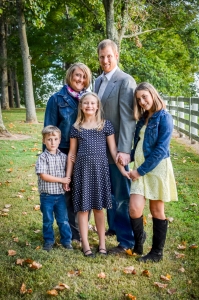One of the challenges of leading children’s, family, or intergenerational ministry is the need to communicate with a large audience of varying needs and perspectives. The target audience ranges from infant to 99+. The intended receivers communicate in vastly different ways. The focus group is never in focus but rather all-encompassing and ever-changing.
Recently, I read a book that really helped me consider this challenge in a new light. In her book, Faith Formation 4.0, Dr. Julie Anne Lytle points out that, “the twenty-first century is unique because it includes cohorts that were significantly shaped by the four eras of human communication.”
So, what might these four eras be?
Oral Tradition
This era of communication was humanity’s first way to communicate through the passing down of wisdom through storytelling. There was a strong sense of community, since this kind of communication relied on face-to-face interaction, and the wisdom shared was passed from one generation to another within a communal context.
Written Text
With the introduction of symbols to represent words, wisdom was able to be passed further than one’s immediate community. You didn’t need to see or even know the person passing on the knowledge; you could read about it! But that was nothing compared to what happened next.
Mass Media
When written text met printing press, the ability to share knowledge became a global phenomenon. Written information could be shared with anyone and passed anywhere. Knowledge no longer required community, just a way to be passed. But it was still one-sided; you could read but you couldn’t respond. Until…
Interactive Communication
Beginning with the telephone and up to the social media connected world of today, not only could you read and pass on information, you could react to it and interact with it without global limitation. A new type of community has risen; a global community of shared and accessible knowledge.
And guess what?
In your church (and in mine) there are generations that give and receive information best in each of these ways.
Some want the face-to-face interaction. They want to hear from you what the vision, mission and needs of the church are. They don’t necessarily want to interact with that information, but they do want to know it. These are the ones who want to “hear it from the pulpit.”
Others prefer to read about it. They want to pick up a piece of literature and read about what is happening in your ministry, in the church, within the community, and around the world. Again, they may not want to interact with it, but they do want to read about it. These are the members of your congregation that “look for it in the bulletin” each week and subscribe to the church newsletter.
 Still others gravitate to mass-produced information that can be accessed and passed on easily, such as brochures about the church and its ministry, reproducible videos that can be used for Bible study or training, books that can be shared from the church library, and a easy-to-read and up-to-date church website.
Still others gravitate to mass-produced information that can be accessed and passed on easily, such as brochures about the church and its ministry, reproducible videos that can be used for Bible study or training, books that can be shared from the church library, and a easy-to-read and up-to-date church website.
Finally, there are those who feel most comfortable with information that allows them to interact with it such as posts on Facebook, small groups focused on discussion, text messages and Snapchat. In fact, there are many in this group that only get their information from these avenues, rarely reading anything they are handed on paper or going to the church website for information.
So what does this mean for us?
- Communication must be multi-faceted – If you want your message to reach the entire congregation, it is necessary to use a variety of avenues to share your information. For one event you may have to have it announced from the pulpit, written in the bulletin, printed in the newsletter, sent out by email and posted on social media.
- Communication must be shared more than once – Let’s assume that Miss P. who only takes things to heart if the Pastor says it from the pulpit misses the one Sunday the announcement is made and Mr. C. who meticulously reads the bulletin each week gives his copy to a visitor… you’ve just missed your chance with them. It’s best to assume you need to share your information multiple times in multiple ways.
- Communication must be timely and interesting – We must face the fact that there are many voices with lots of information vying for people’s attention. Certain times are worse than others to try to get your message across. For instance, when school re-starts, parents are flooded with information from their kids new teachers and schools and information overload is bound to happen. Time your information sharing to reach them before or after the onslaught, again multiple times, in multiple ways.
While this means we have to spend a lot more time working on our communication materials (slides, articles, announcements, videos, social media posts, text reminders, etc) it also means that if we do so, we will have a much better chance of having our voice heard and gathering more generations into our ministry’s mission and vision.
Understanding how members of our congregation receive and interact with information can help us do a better job at ministering to each generation and creating ways for them to all grow together.
For more information about
- Kids in Worship
- Determining which Type of Family Ministry model works best for your church
- Discipleship in Intergenerational community
- Encouraging the continued conversation through Practical Discipleship at Home
- Seminars, Workshops, Coaching
Check out to ReFocus Ministry or “like” our Facebook page. Join our conversation at theReFocus Family and Intergen Ministry group on Facebook.
About the author
 Christina Embree is wife to Pastor Luke, mom to three wonderful kids, and family minister at Nicholasville UMC. She is passionate about seeing churches partnering with families to encourage faith formation at home and equipping parents to disciple their kids in the faith. Currently studying Family, Youth and Children’s Ministry at Wesley Seminary, she also blogs at www.refocusministry.org and is a contributing blogger at D6 Family, Seedbed, and ChildrensMinistryBlog.com
Christina Embree is wife to Pastor Luke, mom to three wonderful kids, and family minister at Nicholasville UMC. She is passionate about seeing churches partnering with families to encourage faith formation at home and equipping parents to disciple their kids in the faith. Currently studying Family, Youth and Children’s Ministry at Wesley Seminary, she also blogs at www.refocusministry.org and is a contributing blogger at D6 Family, Seedbed, and ChildrensMinistryBlog.com

